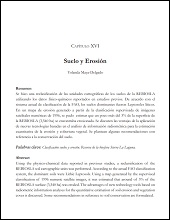Detección de las preferencias de hábitat del borrego cimarrón (Ovis canadensis cremnobates) en Baja California, mediante técnicas de teledetección satelital
Detecting habitat preferences of bighorn sheep (Ovis canadensis cremnobates) in Baja California using remote sensing techniques
Author
JONATHAN GABRIEL ESCOBAR FLORES
SERGIO ALVAREZ CARDENAS
JORGE TORRES RODRIGUEZ
SARA CECILIA DIAZ CASTRO
ARADIT CASTELLANOS VERA
ROBERTO MARTINEZ GALLARDO
Metadata
Show full item recordAbstract
"El terreno de escape y la cobertura vegetal son dos componentes vitales en el hábitat del borrego cimarrón. La evaluación de la selección que hacen los borregos cimarrones de estos componentes es fundamental para determinar su distribución y el número de organismos que puede soportar un área. A pesar de la importancia de evaluar la selección del hábitat, son pocos los estudios realizados en México sobre el tema. La mayoría de las iniciativas se han enfocado en monitoreos poblacionales. La carencia de estudios sobre el hábitat del borrego cimarrón en Baja California no permite pronosticar los posibles efectos del cambio climático (e. g. una reducción en la disponibilidad de alimento como consecuencia de periodos largos sin lluvias ha ocasionado que varias poblaciones de borregos en el desierto se extirpen). Los objetivos de este estudio fueron determinar la disponibilidad del terreno de escape en diferentes categorías de rugosidad del terreno (plano, sierras bajas, cañones y sierras altas). Asimismo, mediante un índice de vegetación, se determinó la disponibilidad de la cobertura vegetal. Se analizó la preferencia de uso y la selección que hace el borrego cimarrón de las variables del hábitat. Se espera que los resultados de este estudio sirvan para la identificación de sitios a fin de manejar y conservar el Ovis canadensis y su hábitat en Sierra Santa Isabel, Baja California." "Escape terrain and vegetation cover are two vital components in bighorn sheep habitat use. Understanding these components is essential for conserving and managing this species. Despite the importance of assessing habitat use, there are few studies in Mexico and most efforts have focused on population surveys. The lack of studies of bighorn sheep habitat in Baja California does not allow predicting possible effects of climate change, for example, reduction in availability of forage and less rainfall and increasing local extinctions of sheep populations in desert areas. Our objectives were to assess availability of escape terrain in topographic areas of varying ruggedness (flat, low hills, canyons, and steep mountains) and availability of plant cover, using an index of normalized difference in vegetation within the Sierra Santa Isabel. Additionally, selection of topographic ruggedness and vegetation cover by bighorn sheep was analyzed. The results of this study will serve to identify sites for conservation and management of Ovis canadensis and their habitat in the Baja California Peninsula."
Collections
Related items
Showing items related by title, author, creator and subject.
-
PROMOCIÓN DEL PERIFITON PARA EL CULTIVO DE CAMARÓN BLANCO: HACIA UNA ACUICULTURA ECOLÓGICA
DOMENICO VOLTOLINA LOBINA; JUAN MANUEL AUDELO NARANJO; MARIA DEL ROSARIO PACHECO MARGES -
Suelo y Erosión
YOLANDA LOURDES MAYA DELGADO


